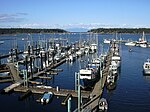The Nanaimo Bastion is a historical octagon-shaped blockhouse located at 98 Front Street in Nanaimo, British Columbia, Canada. The Hudson's Bay Company, which then held a royal lease on all of what was then the Colony of Vancouver Island, built it between 1853 and 1855 to defend its coal mining operations in Nanaimo. It has been called "Nanaimo's premier landmark", because of its shape and its high visibility from both land and sea.The Bastion was constructed using the pièce-sur-pièce (post-and-plank) method. This entailed laying timbers across each other horizontally, with tenons cut into the ends. These tenons would then be inserted into vertical posts. This method was used partially due to the expensive cost of nails; by using the pièce-sur-pièce method, very few nails were needed. The logs were squared using only basic hand tools: a crosscut saw, broadaxe, adze, auger and pit saw. The wooden structure sat on a masonry foundation and was three stories tall. It is the only remaining freestanding tower structure built by the Hudson's Bay Company.In 1891, the Bastion faced demolition threats. The city, recognising the historic value of the building, paid a sum of $175 for the building and moved it across the street from its original location (this would be the parking lot of the modern day Dorchester Hotel). It was moved a second time in 1979, when the roads were being widened. On December 12, 1985, the city of Nanaimo designated it a local heritage site. During the summer of 2010, the Bastion was torn apart to renew rotting boards and add stabilizing steel beams. The director of the event said that they were "making a historic movement".
The Bastion is managed by the Nanaimo Museum and is open to visitors during the summer (May Long to Labour Day) from 9:00 am to 5:00 pm (hours subject to change). It functions as a tourist information center on behalf of Tourism Nanaimo, and holds exhibits on the history of the building. The Nanaimo Museum also hosts a daily cannon firing at noon during the summer months, just a few feet away from the Bastion.The Bastion is the main image on HMCS Nanaimo's ships crest. HMCS Nanaimo is a Kingston-class Coastal Defence vessel that has been serving in the Royal Canadian Navy since 1997.









